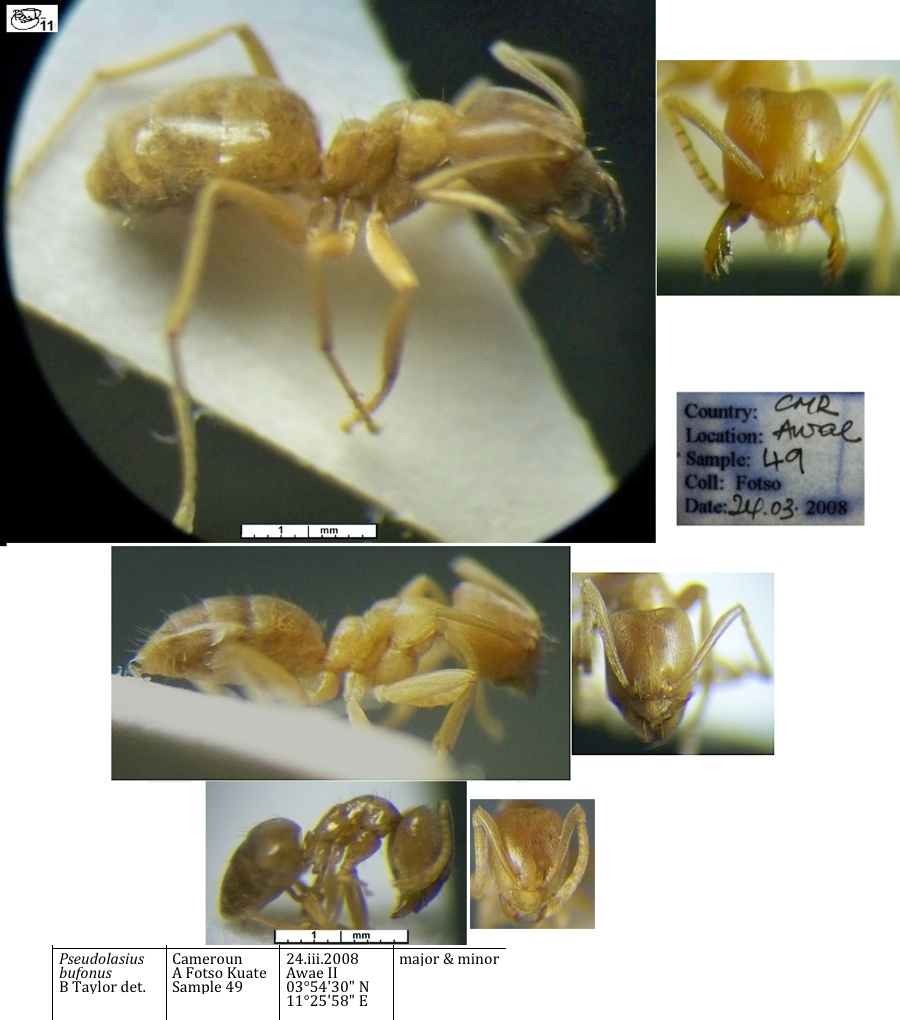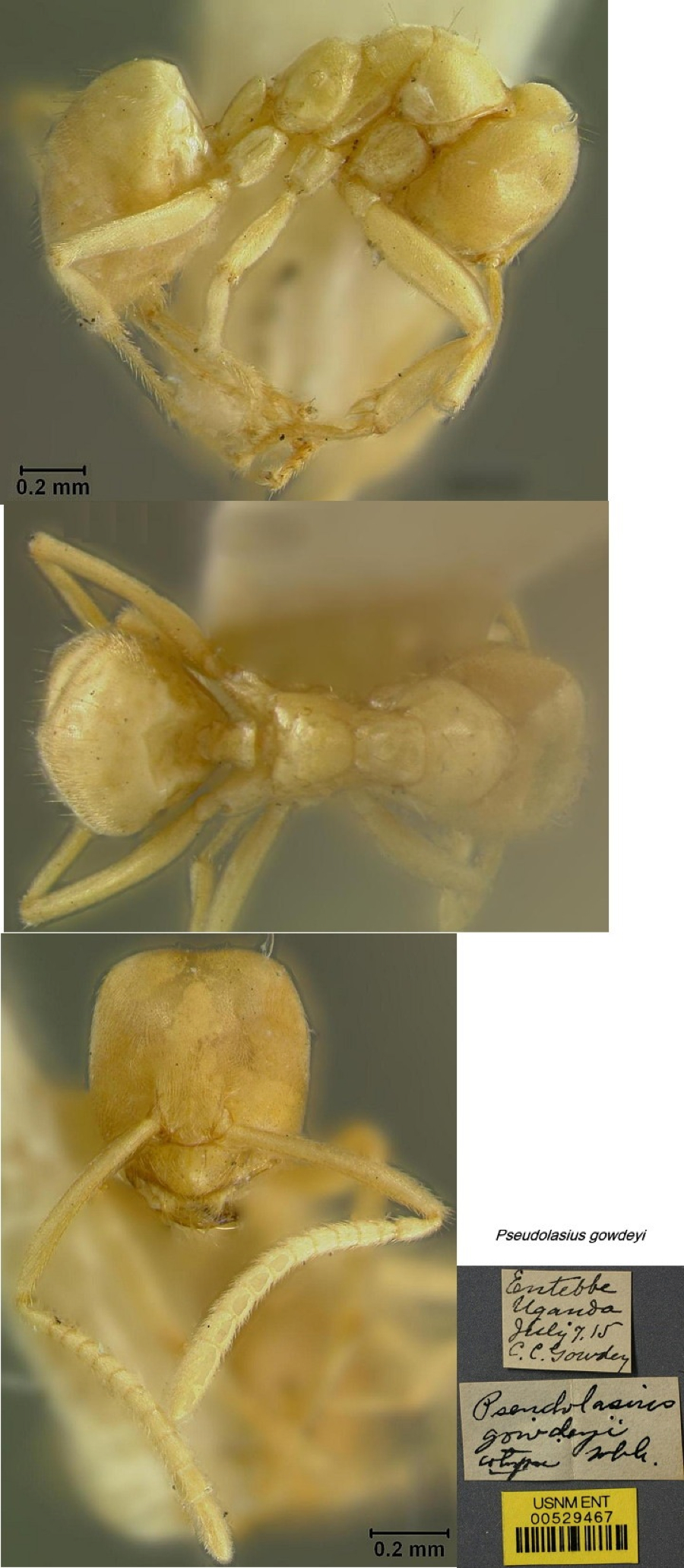Pseudolasius bufonus Wheeler
  Type location Zaïre
(Pseudolasius bufonum new
species, Wheeler, 1922: 220, illustrated, all forms), see Bolton, 1995) Type location Zaïre
(Pseudolasius bufonum new
species, Wheeler, 1922: 220, illustrated, all forms), see Bolton, 1995)
junior synonym gowdeyi (Pseudolasius
gowdeyi new species,Wheeler, 1922: 223, illustrated,
soldier & worker) from Uganda - new synonymy (2011)
all
stages known  . .
|
Wheeler's (1922) descriptions of the
Congo Basin species is at  . .
 Wheeler's
description is as follows - Wheeler's
description is as follows -
WORKER MAJOR [probably a media worker, see below] - length 2.8 to 3 mm.
Head scarcely longer than broad,
subrectangular, with nearly straight, subparallel sides and sinuately
excised posterior border. Mandibles 5-toothed, the median tooth small,
the apical long and pointed, the others shorter and subequal. Clypeus
convex, subcarinate in the middle, its anterior border entire, only
slightly projecting over the bases of the mandibles. Eyes very small *,
consisting of only three or four ommatidia, situated a little in front
of the median transverse diameter of the head. Antennal scapes not
reaching to the posterior corners of the head; first funicular joint
longer than the two succeeding joints together; second joint as broad
as long, joints 3 to 7 slightly longer than broad. Thorax short, stout;
pronotum large and broad, longer than the mesonotum, which is as long
as broad; propodeum broader than long. In profile the pro- and
mesonotum form a large convexity with rather uneven outline,
interrupted by the strong promesonotal suture. Metanotal groove short
and not very deep, the stigmata prominent. Propodeum decidedly lower
than the mesonotum, in profile rounded and sloping, with very short
base and long sloping declivity. Petiole small, rather strongly
compressed antero-posteriorly, with entire superior border, Gaster
elongate elliptical. Legs rather stout. Mandibles opaque, very finely
and longitudinally striated. Remainder of body shining, very finely and
rather densely punctate, but not more coarsely on the head and thorax
than on the gaster. Clypeus smoother and more shining than the
remainder of the head. Hairs and pubescence yellowish, abundant; the
former erect, longest on the thoracic dorsum, sparser and shorter on
the scapes and legs; pubescence rather long and dense over the whole
body but only slightly obscuring the shining surface. Yellowish brown;
gaster and appendages paler and more yellow; mandibles castaneous,
their teeth and a blotch on the vertex blackish.
Note: * none of
the several Cameroun specimens have eyes and the cotypes below also
show no sign of eyes
|
![[Pseudolasius bufonus]](pseudolasius_bufonus_usnm529035.jpg) The
photomontage of a cotype is collated from The
Smithsonian Institute images at http://ripley.si.edu The
photomontage of a cotype is collated from The
Smithsonian Institute images at http://ripley.si.edu
The fresh Cameroun specimens (see below) show that this is a media
worker. |
WORKER MINOR - length 2.5 to 3 mm. Differing from the
major worker in the shape of the head, which is decidedly smaller,
distinctly longer than broad, with straight sides and only feebly
excised posterior border. Eyes reduced to a single ornmatidium or
absent. Antennal scapes reaching to the posterior corners of the head;
first funicular joint broader than long, joints 3 to 7 not longer than
broad. Sculpture, pilosity, and color as in the major worker, but the
black spot on the vertex fainter or altogether absent.
|
FEMALE - length 5.5 to 6 mm. Head, excluding the
mandibles, broader than long, slightly broader behind than in front,
with feebly convex sides and broadly and feebly excised posterior
border. Eyes slightly convex, very broadly elliptical, occupying the
median third of the sides of the head. Antennal scapes extending nearly
one-third their length beyond the posterior corners of the head; all
the funicular joints longer than broad. Thorax broader than the head;
the mesonotum and scutellum flattened. Apical border of petiole blunt,
straight, and transverse. Gaster large, elliptical. Wings long.
Sculpture, pilosity, and color much as in the worker, but the body
darker brown, the gaster not paler than the thorax. Anterior border of
clypeus blackish. Hairs lacking (possibly rubbed off), pubescence
shorter and more delicate, and the surface, especially of the head and
thorax, somewhat more opaque than in the worker. Wings blackish, with
dark brown veins and pterostigma.
|
MALE - length 2.5 mm. Head as broad, as long, somewhat
narrowed behind and in front. Eyes convex, hemispherical, somewhat in
front of the middle of the sides, the posterior border nearly straight.
Mandibles denticulate, overlapping. Clypeus convex, Antennal scapes
extending about one-fourth their length beyond the posterior border of
the head; all the funicular joints distinctly longer than broad, the
first nearly as long as the two succeeding joints together. Thorax and
petiole shaped somewhat as in the female. Gaster and legs slender,
external genital valves rather long and pointed. Sculpture and pilosity
much as ill the worker. Color yellowish brown above, with brownish
yellow appendages, genitalia, venter, and anterior portion of head.
Ocellar triangle dark brown. Wings paler than in the female.
Described from four major and eleven minor workers,
three females, and eight males, all taken from the stomachs of toads (Bufo
superciliaris and polycercus) captured at Medje (Lang and
Chapin). This species differs from weissi in the shape of the
head of the major worker, the slightly larger eyes, more strongly
striated and more opaque mandibles, shorter antenna, and much more
abundant pilosity and pubescence, and especially in having erect hairs
on the scapes and legs. The female is smaller than that of weissi,
with a differently shaped head, less excised behind, larger and more
nearly circular eyes and longer antennae.
|
Oxford University
Museum
specimens
Pseudolasius bufonus
B Taylor det. |
Cameroun
A Fotso Kuate
Sample 49
|
24.iii.2008
Awae II
03°54'30" N
11°25'58" E
|
major & minor
|
2
|
 |
Pseudolasius bufonus
B Taylor det. |
Cameroun
A Fotso Kuate
Sample 37
|
17.vii.2007
Awae II
03°54'30" N
11°25'58" E
|
minors
|
1
|
 |
|
 The photomontage shows the
polymorphism of workers from Cameroun; Awae II;
collector A Fotso Kuate (fk unmounted 49) The photomontage shows the
polymorphism of workers from Cameroun; Awae II;
collector A Fotso Kuate (fk unmounted 49)
See the Cameroun
specimens page
|
Pseudolasius gowdeyi Wheeler
Type location Uganda
(Wheeler, 1922: 223, illustrated, soldier & worker); soldier and
worker only described (see Bolton, 1995)  . .
|
 Wheeler's
description was - Wheeler's
description was -
WORKER MAJOR - length 2.5 mm. Head as broad as long, subrectangular, as
broad in front as behind, with straight sides and feebly but distinctly
excised posterior border. Eyes absent. Mandibles with five acute teeth
on their oblique apical borders, the median tooth small, the apical
twice as long as the other three. Clypeus convex but not carinate, its
anterior border nearly straight. Antennae slender, the scapes extending
about one-fifth their length beyond the posterior corners of the head;
the second funicular joint not longer than broad, the succeeding joints
slightly longer than broad. Thorax short and robust, the pro- and
mesonotum forming together an evenly rounded convexity; mesopleura
somewhat compressed; propodeum short, nearly horizontal, lower than the
mesonotum, passing through a curve into the sloping, flat declivity.
Petiolar scale narrowed above, its sides curved, its superior border
rather blunt, truncated, entire. Gaster elliptical. Legs rather short.
Whole body smooth and shining, except the mandibles) which are opaque
and very finely and densely striated. Integument of the body and
appendages apparently microscopically but not densely punctate. Hairs
and pubescence white, the former sparse, conspicuous only on the
clypeus, thorax, and gaster, the appendages being without erect hairs.
Pubescence short, rather dense on the head and gaster, longer on the
latter, slightly oblique on the scapes and legs. Pale yellow, the head
and thorax a little darker, mandibular teeth dark brown.
WORKER MINOR - length 1.8 to 2 mm. Differing from the
major worker in its smaller head, which is elongate and with very
feeble occipital excision. Antennal scapes reaching nearly one-fourth
their length beyond the posterior corners of the head; joints 2 to 6 of
the funicuhls as broad as long.
Described from two major and sixteen minor workers taken
by Mr. C. C. Gowdey at Entebbe, Uganda. They were found attending
subterranean coccids (Risso) about the roots of coffee. This is
readily distinguished from all the preceding species by its smaller
size, paler color, the complete absence of eyes even in the major
workers, the shape of the head and thorax, and the pilosity.
|
 The
photomontage of a cotype is collated from The Smithsonian Institute
images at http://ripley.si.edu/ The
photomontage of a cotype is collated from The Smithsonian Institute
images at http://ripley.si.edu/
The fresh Cameroun specimens (above) show that this is a minor worker.
|
 The
photomontage of the sordida
type, clearly a small minor (compared to the
type minor above) is collated from - http://www.antweb.org/specimen.do?name=casent0912330 The
photomontage of the sordida
type, clearly a small minor (compared to the
type minor above) is collated from - http://www.antweb.org/specimen.do?name=casent0912330
|
|